From 21 till 30 September 2016, during the Netherlands Film Festival (NFF), and traditionally EFSP organises its own little festival, the UNFPF (Unofficial Netherlands Film Postcard Festival). Today a film special on the comedy De familie van mijn vrouw/My Wife's Family (Jaap Speyer, 1935). Critics at the time described it as the worst film of the Dutch film industry...
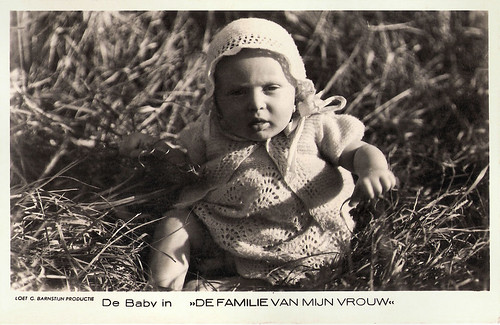
Dutch postcard by M. B.& Z. (M. Bonnist & Zonen, Amsterdam). Photo: Loet C. Barnstijn Productie. Publicity still for De familie van mijn vrouw/My Wife's Family (1935). Caption: The baby in My Wife's Family.
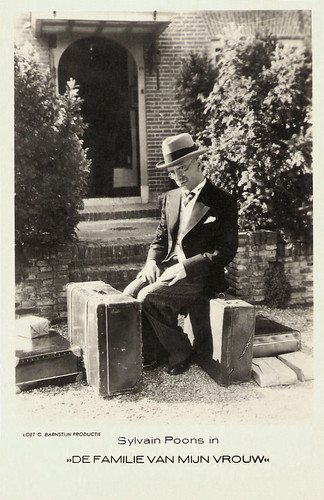
Dutch postcard by M. B.& Z. (M. Bonnist & Zonen, Amsterdam). Photo: Loet C. Barnstijn Productie. Sylvain Poons in De familie van mijn vrouw/My Wife's Family (1935).
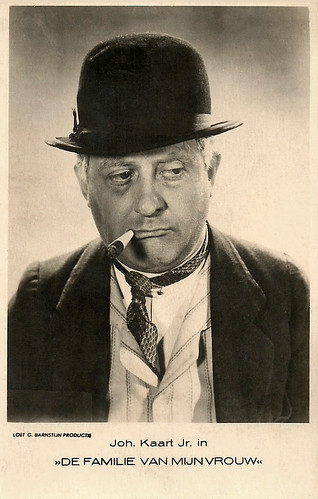
Dutch postcard by M. B.& Z. (M. Bonnist & Zonen, Amsterdam). Photo: Loet C. Barnstijn Productie. Johan Kaart Jr. in the Dutch comedy De familie van mijn vrouw/My Wife's Family (1935).
The Dutch comedy De familie van mijn vrouw/My Wife's Family (1935) was directed by veteran director Jaap Speyer (1891–1952). He studied art history in Amsterdam and before the First World War he came in contact with theatre.
Speyer left the Netherlands for Hamburg, Germany, where actors introduced him to the film industry. In 1917 he moved to Berlin to study film. At 26, he made his first film Wenn Frauen lieben und hassen/When Women Love and Hate (1917). The drama starred Ernst Hoffmann, the script writer, Marta Orlanda, Ludwig Hartau, Werner Krauss and Mia Pankau. Pankau became Speyer's wife and she was the star of many of his German films.
Between 1917 and 1933, Jaap Speyer made 50 silent films in Germany. These included 'traffick films', dramas about white slave trade and prostitution, like Liebeshandel/Love Trade (1927) with Anita Dorris, and Tänzerinnen für Süd-America gesucht/Girls for Sale (1931) with Dita Parlo. He also made other films about provocative subjects, such as Bigamie/Bigamy (1927) with Heinrich George and Italian diva Maria Jacobini.
In 1933, during the change of power in Germany and the rise of Nazism, Jaap Speyer returned to the Netherlands. He was offered to direct the musical De Jantjes/The Tars (1934). It became an unprecedented box office hit with more than 100,000 visitors in The Netherlands. Next he made the comedies Malle gevallen/Silly Situations (1934) and De familie van mijn vrouw/My Wife's Family (1935).
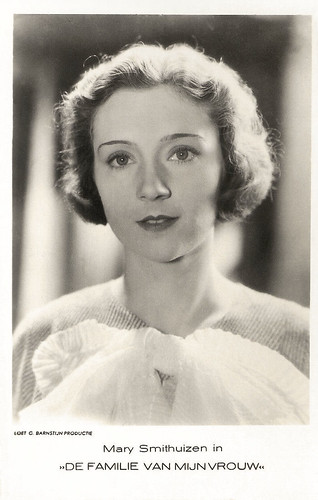
Dutch postcard by M. B.& Z. (M. Bonnist & Zonen, Amsterdam). Sent by mail in 1936. Photo: Loet C. Barnstijn Productie. Mary Smithuysen in De familie van mijn vrouw/My Wife's Family (1935).
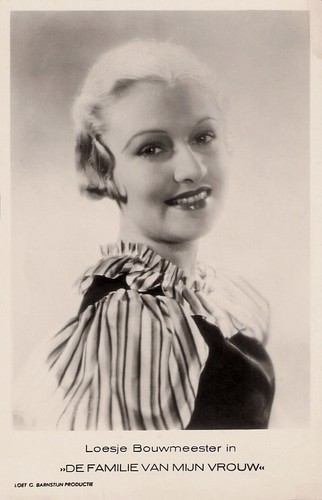
Dutch postcard by M. B.& Z. (M. Bonnist & Zonen, Amsterdam). Photo: Loet C. Barnstijn Productie. Loesje Bouwmeester in De familie van mijn vrouw/My Wife's Family (1935).
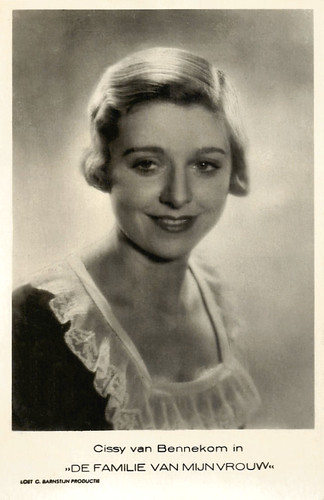
Dutch postcard by M. B.& Z. (M. Bonnist & Zonen, Amsterdam). Photo: Loet C. Barnstijn Productie. Cissy van Bennekom in De familie van mijn vrouw/My Wife's Family (1935).
De familie van mijn vrouw/My Wife's Family was based on a boulevard play by Alfred Duprez and A. Milo Bennet.
It is a comedy of errors centred around the Goedhart family, a piano and the baby of a servant girl (Cissy van Bennekom) whose existence is unknown to all.
Gusta Chrispijn-Mulder plays the nagging mother, is constantly checking her put-upon husband (Sylvain Poons) and their two daughters and imposing them her will.
One of the daughters (Loesje Bouwmeester) has ambitions to become a film star and the other (Mary Smithuysen) is happily married to a writer who loathes his mother-in-law. Another part was played by music hall star Johan Kaart.
Speyer's third Dutch feature film was greeted less enthusiastically than his earlier efforts. Critics described it as the worst film of the Dutch film industry ever.
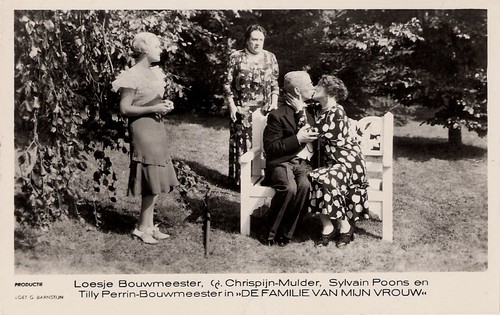
Dutch postcard by M. B.& Z. (M. Bonnist & Zonen, Amsterdam). Photo: Loet C. Barnstijn Productie. Loesje Bouwmeester, Gusta Chrispijn-Mulder, Sylvain Poons and Tilly Perin-Bouwmeester in De familie van mijn vrouw/My Wife's Family (1935).
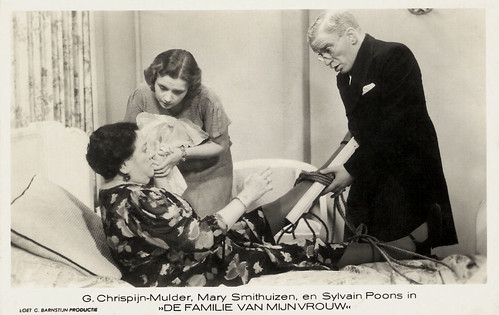
Dutch postcard by M. B.& Z. (M. Bonnist & Zonen, Amsterdam). Photo: Loet C. Barnstijn Productie. Mary Smithuysen, Gusta Chrispijn-Mulder and Sylvain Poons in De familie van mijn vrouw/My Wife's Family (1935).
Sources: Eye (Dutch), Wikipedia (Dutch) and IMDb.

Dutch postcard by M. B.& Z. (M. Bonnist & Zonen, Amsterdam). Photo: Loet C. Barnstijn Productie. Publicity still for De familie van mijn vrouw/My Wife's Family (1935). Caption: The baby in My Wife's Family.

Dutch postcard by M. B.& Z. (M. Bonnist & Zonen, Amsterdam). Photo: Loet C. Barnstijn Productie. Sylvain Poons in De familie van mijn vrouw/My Wife's Family (1935).

Dutch postcard by M. B.& Z. (M. Bonnist & Zonen, Amsterdam). Photo: Loet C. Barnstijn Productie. Johan Kaart Jr. in the Dutch comedy De familie van mijn vrouw/My Wife's Family (1935).
Jaap Speyer
The Dutch comedy De familie van mijn vrouw/My Wife's Family (1935) was directed by veteran director Jaap Speyer (1891–1952). He studied art history in Amsterdam and before the First World War he came in contact with theatre.
Speyer left the Netherlands for Hamburg, Germany, where actors introduced him to the film industry. In 1917 he moved to Berlin to study film. At 26, he made his first film Wenn Frauen lieben und hassen/When Women Love and Hate (1917). The drama starred Ernst Hoffmann, the script writer, Marta Orlanda, Ludwig Hartau, Werner Krauss and Mia Pankau. Pankau became Speyer's wife and she was the star of many of his German films.
Between 1917 and 1933, Jaap Speyer made 50 silent films in Germany. These included 'traffick films', dramas about white slave trade and prostitution, like Liebeshandel/Love Trade (1927) with Anita Dorris, and Tänzerinnen für Süd-America gesucht/Girls for Sale (1931) with Dita Parlo. He also made other films about provocative subjects, such as Bigamie/Bigamy (1927) with Heinrich George and Italian diva Maria Jacobini.
In 1933, during the change of power in Germany and the rise of Nazism, Jaap Speyer returned to the Netherlands. He was offered to direct the musical De Jantjes/The Tars (1934). It became an unprecedented box office hit with more than 100,000 visitors in The Netherlands. Next he made the comedies Malle gevallen/Silly Situations (1934) and De familie van mijn vrouw/My Wife's Family (1935).

Dutch postcard by M. B.& Z. (M. Bonnist & Zonen, Amsterdam). Sent by mail in 1936. Photo: Loet C. Barnstijn Productie. Mary Smithuysen in De familie van mijn vrouw/My Wife's Family (1935).

Dutch postcard by M. B.& Z. (M. Bonnist & Zonen, Amsterdam). Photo: Loet C. Barnstijn Productie. Loesje Bouwmeester in De familie van mijn vrouw/My Wife's Family (1935).

Dutch postcard by M. B.& Z. (M. Bonnist & Zonen, Amsterdam). Photo: Loet C. Barnstijn Productie. Cissy van Bennekom in De familie van mijn vrouw/My Wife's Family (1935).
Comedy of errors
De familie van mijn vrouw/My Wife's Family was based on a boulevard play by Alfred Duprez and A. Milo Bennet.
It is a comedy of errors centred around the Goedhart family, a piano and the baby of a servant girl (Cissy van Bennekom) whose existence is unknown to all.
Gusta Chrispijn-Mulder plays the nagging mother, is constantly checking her put-upon husband (Sylvain Poons) and their two daughters and imposing them her will.
One of the daughters (Loesje Bouwmeester) has ambitions to become a film star and the other (Mary Smithuysen) is happily married to a writer who loathes his mother-in-law. Another part was played by music hall star Johan Kaart.
Speyer's third Dutch feature film was greeted less enthusiastically than his earlier efforts. Critics described it as the worst film of the Dutch film industry ever.

Dutch postcard by M. B.& Z. (M. Bonnist & Zonen, Amsterdam). Photo: Loet C. Barnstijn Productie. Loesje Bouwmeester, Gusta Chrispijn-Mulder, Sylvain Poons and Tilly Perin-Bouwmeester in De familie van mijn vrouw/My Wife's Family (1935).

Dutch postcard by M. B.& Z. (M. Bonnist & Zonen, Amsterdam). Photo: Loet C. Barnstijn Productie. Mary Smithuysen, Gusta Chrispijn-Mulder and Sylvain Poons in De familie van mijn vrouw/My Wife's Family (1935).
Sources: Eye (Dutch), Wikipedia (Dutch) and IMDb.
No comments:
Post a Comment